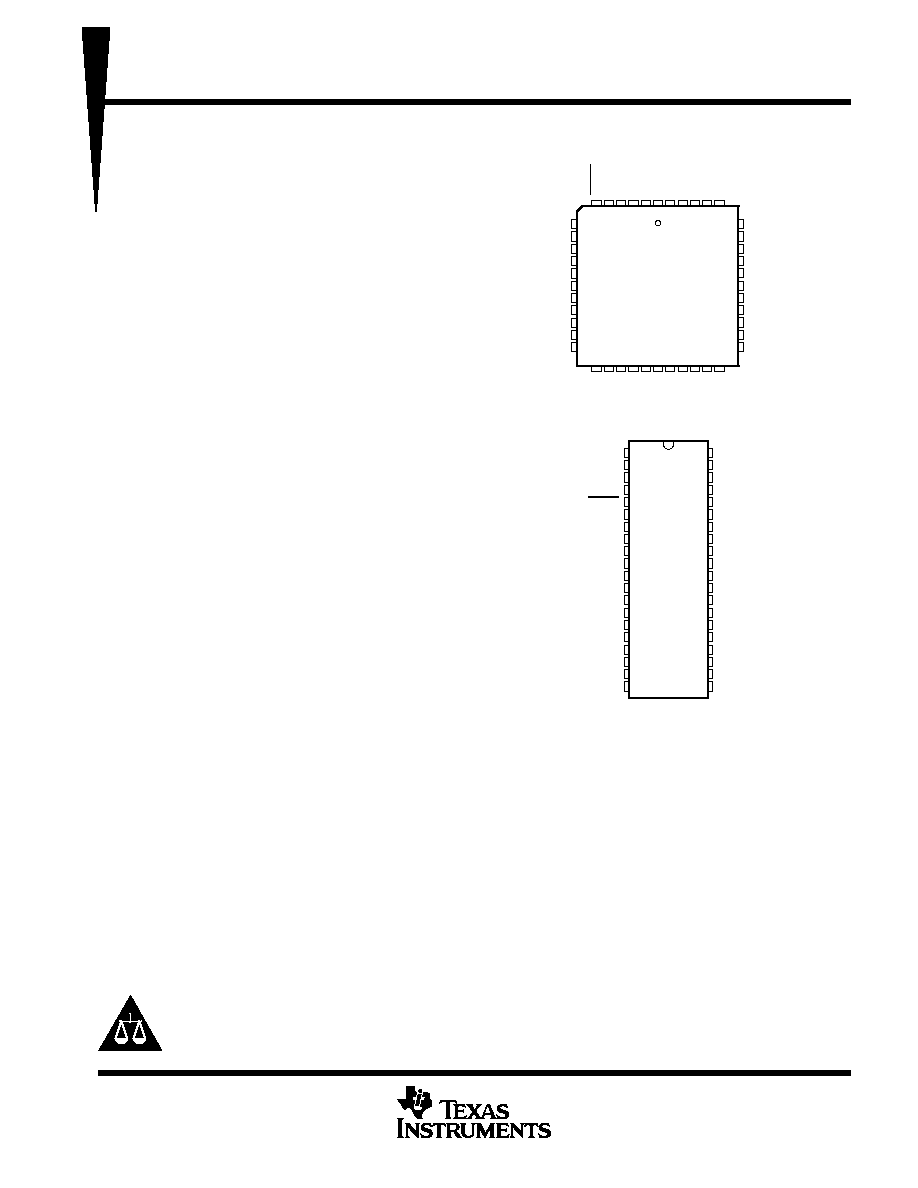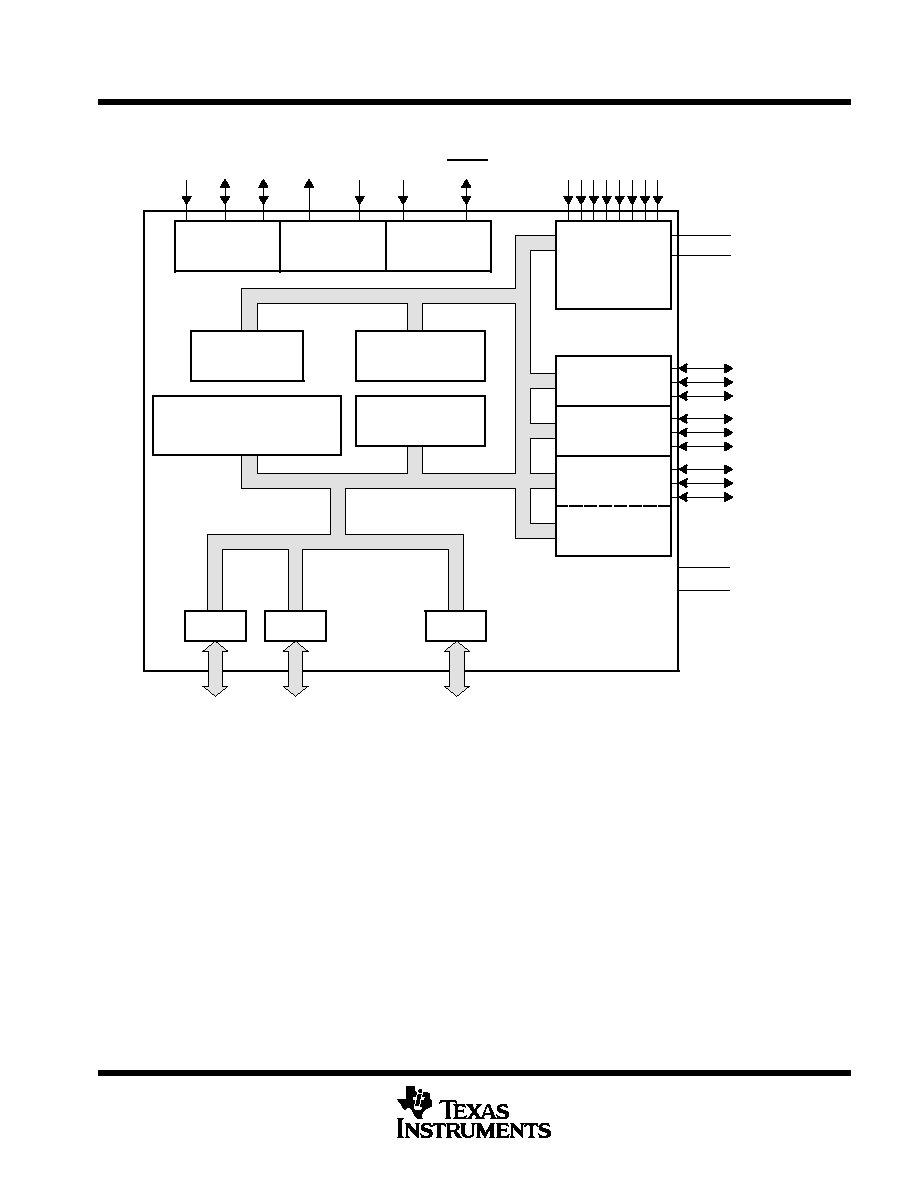
Please be aware that an important notice concerning availability, standard warranty, and use in critical applications of
Texas Instruments semiconductor products and disclaimers thereto appears at the end of this data sheet.
TMS370Cx4x
8-BIT MICROCONTROLLER
SPNS016C ≠ NOVEMBER 1992 ≠ REVISED FEBRUARY 1997
1
POST OFFICE BOX 1443
∑
HOUSTON, TEXAS 77251≠1443
D
CMOS/EEPROM/EPROM Technologies on a
Single Device
≠ Mask-ROM Devices for High Volume
Production
≠ One-Time-Programmable (OTP) Devices
for Low-Volume Production
≠ Reprogrammable EPROM Devices for
Prototyping Purposes
D
Flexible Operating Features
≠ Low-Power Modes: STANDBY and HALT
≠ Commercial, Industrial, and Automotive
Temperature Ranges
≠ Clock Options:
≠ Divide-by-1 (2 MHz ≠ 5 MHz SYSCLK)
Phase-Locked Loop (PLL)
≠ Divide-by-4 (0.5 MHz ≠ 5 MHz SYSCLK)
≠ Voltage (V
CC
) 5 V
±
10%
D
Internal System Memory Configurations
≠ On-Chip Program Memory Versions
≠ ROM: 4K Bytes or 8K Bytes
≠ EPROM: 8K Bytes
≠ Data EEPROM: 256 Bytes
≠ Static RAM: 256 Bytes Usable as
Registers
D
Two 16-Bit General-Purpose Timers
≠ Software Configurable as
Two 16-Bit Event Counters, or
Two 16-Bit Pulse Accumulators, or
Three 16-Bit Input Capture Functions, or
Four Compare Registers, or
Two Self-Contained
Pulse-Width-Modulation (PWM)
Functions
D
Serial Communications Interface 1 (SCI1)
≠ Asynchronous and Isosynchronous
Modes
≠ Full Duplex, Double Buffered RX and TX
≠ Two Multiprocessor Communications
Formats
D
CMOS/Package/ TTL Compatible I/O Pins
≠ All Peripheral Function Pins Software
Configurable for Digital I/O
≠ 40-Pin Plastic and Ceramic Dual-In-Line
Packages / 27 Bidirectional, 5 Input Pins
≠ 44-Pin Plastic and Ceramic Leaded Chip
Carrier Packages/27 Bidirectional, 9
Input Pins
D
On-Chip 24-Bit Watchdog Timer
D
Eight-Bit ADC1
≠ Four Channels in 40-Pin Packages
≠ Eight Channels in 44-Pin Packages
D
Flexible Interrupt Handling
D
TMS370 Series Compatibility
D
Workstation/PC-Based Development
System
≠ C Compiler Support
≠ Real-Time In-Circuit Emulation
≠ C Source Debug
≠ Extensive Breakpoint/Trace Capability
≠ Software Performance Analysis
≠ Multi-Window User Interface
≠ EEPROM/EPROM Programming
JC, JD, N, AND NJ PACKAGES
( TOP VIEW )
FN AND FZ PACKAGES
( TOP VIEW )
B2
T2AEVT
T2AIC2/PWM
T2AIC1/CR
RESET
INT1
INT2
INT3
VCC
A7
A6
VSS
A5
A4
A3
A2
A1
A0
D7
D4
1
2
3
4
5
6
7
8
9
10
11
12
13
14
15
16
17
18
19
20
40
39
38
37
36
35
34
33
32
31
30
29
28
27
26
25
24
23
22
21
B1
B0
SCITXD
SCIRXD
SCICLK
D5
MC
XTAL2/CLKIN
XTAL1
T1IC/CR
T1PWM
T1EVT
AN7
AN6
VCC3
VSS3
AN3
AN2
D6
D3
MC
XTAL2/CLKIN
XTAL1
T1IC/CR
T1PWM
T1EVT
AN7
AN6
AN5
AN4
VSS3
39
38
37
36
35
34
33
32
31
30
29
18 19
7
8
9
10
11
12
13
14
15
16
17
INT1
INT2
INT3
VCC
VCC3
A7
A6
VSS
A5
A4
A3
20 21 22 23
SCITXD
SCIRXD
SCICLK
D5
5 4 3 2 1
6
44
RESET
T2AIC1
/
C
R
T2AIC2
/
P
WM
T2AEVT
B2
B1
B0
AN0
AN1
AN2
A2
A1
A0
D7
D4
D6
42 41 40
43
24 25 26 27 28
AN3
D3
PRODUCTION DATA information is current as of publication date.
Products conform to specifications per the terms of Texas Instruments
standard warranty. Production processing does not necessarily include
testing of all parameters.
Copyright
©
1997, Texas Instruments Incorporated
Isosynchronous = Isochronous

TMS370Cx4x
8-BIT MICROCONTROLLER
SPNS016C ≠ NOVEMBER 1992 ≠ REVISED FEBRUARY 1997
2
POST OFFICE BOX 1443
∑
HOUSTON, TEXAS 77251≠1443
Pin Descriptions
PIN
NO.
TYPE
DESCRIPTION
DIP (40)
LCC (44)
A0
A1
A2
A3
A4
A5
A6
A7
18
17
16
15
14
13
11
10
20
19
18
17
16
15
13
12
I/O
Port A pins are general-purpose bidirectional I/O ports.
B0
B1
B2
39
40
1
44
1
2
I/O
Port B pins are general-purpose bidirectional I/O ports.
D3
D4
D5
D6
D7
21
20
35
22
19
23
22
40
24
21
I/O
Port D pins are general-purpose bidirectional I/O ports.
D3 is also configurable as SYSCLK.
AN0/E0
AN1/E1
AN2/E2
AN3/E3
AN4/E4
AN5/E5
AN6/E6
AN7/E7
--
--
23
24
--
--
27
28
25
26
27
28
30
31
32
33
I
Analog-to-digital converter 1 (ADC1) analog input channels or positive reference pins; any
ADC1 channel can be programmed as general-purpose input pin (E port) if not used as an
analog input or reference channel.
VCC3
VSS3
26
25
11
29
ADC1 converter positive supply voltage and optional positive reference input pin
ADC1 converter ground supply and low reference input pin
INT1
INT2
INT3
6
7
8
7
8
9
I
I/O
I/O
External (non-maskable or maskable) interrupt/general-purpose input pin
External maskable interrupt input/general-purpose bidirectional pin
External maskable interrupt input/general-purpose bidirectional pin
T1IC/CR
T1PWM
T1EVT
31
30
29
36
35
34
I/O
Timer 1 input capture/counter reset input pin/general-purpose bidirectional pin
Timer 1 pulse-width-modulation output pin/general-purpose bidirectional pin
Timer 1 external event input pin/general-purpose bidirectional pin
T2AIC1/CR
T2AIC2/PWM
T2AEVT
4
3
2
5
4
3
I/O
Timer 2A input capture/counter reset input pin/general-purpose bidirectional pin
Timer 2A input capture 2/PWM output pin/general-purpose bidirectional pin
Timer 2A external event input pin/general-purpose bidirectional pin
SCITXD
SCIRXD
SCICLK
38
37
36
43
42
41
I/O
SCI transmit data output pin/general-purpose bidirectional pin
SCI receive data input pin/general-purpose bidirectional pin
SCI bidirectional serial clock pin/general-purpose bidirectional pin
RESET
5
6
I/O
System reset bidirectional pin. As input, RESET initializes microcontroller; as open-drain
output, RESET indicates detection of an internal fault by the watchdog or oscillator fault cir-
cuit.
MC
34
39
I
Mode control input pin; enables the EEPROM write-protection-override (WPO) mode, also
EPROM VPP.
XTAL1
XTAL2/CLKIN
32
33
37
38
I
O
Internal-oscillator output for crystal
Internal-oscillator crystal input/external clock source input
VCC
VSS
9
12
10
14
Positive supply voltage
Ground reference
I = input, O = output
The three-pin configuration SCI is referred to as SCI1.

TMS370Cx4x
8-BIT MICROCONTROLLER
SPNS016C ≠ NOVEMBER 1992 ≠ REVISED FEBRUARY 1997
3
POST OFFICE BOX 1443
∑
HOUSTON, TEXAS 77251≠1443
functional block diagram
Interrupts
Clock Options
Divide-by-4 or
Divide-by-1(PLL)
System
Control
INT1
AN0≠AN7
INT2
INT3
MC
RESET
XTAL1
A-to-D
Converter 1
Timer 2A
Timer 1
Watchdog
Serial
Communications
Interface 1
RAM
256 Bytes
(Usable as Registers)
Program Memory
ROM: 4K or 8K Bytes
EPROM:8K Bytes
Data EEPROM
0 or 256 Bytes
CPU
XTAL2/
CLKIN
SCIRXD
SCITXD
SCICLK
T2AIC1 / CR
T2AEVT
T2AIC2 / PWM
T1IC/CR
T1EVT
T1PWM
VCC
VSS
VCC3
VSS3
Port B
Port A
Port D
8
3
5
(40-Pin: 4 CH)
(44-Pin: 8 CH)
40-PIN DIP: AN2, AN3,
AN6, AN7
44-PIN PLCC:AN0≠AN7
description
The TMS370C040A, TMS370C042A, TMS370C340A, TMS370C342A, TMS370C742A, and SE370C742A
devices are members of the TMS370 family of single-chip 8-bit microcontrollers. Unless otherwise noted, the
term TMS370Cx4x refers to these devices. TMS370 family provides cost-effective real-time system control
through integration of advanced peripheral function modules and various on-chip memory configurations.
The TMS370Cx4x family is implemented using high-performance silicon-gate CMOS EPROM and EEPROM
technology. The low-operating power, wide-operating temperature range, and noise immunity of CMOS
technology coupled with the high performance and extensive on-chip peripheral functions make the
TMS370Cx4x devices attractive in system designs for automotive electronics, industrial motor, computer
peripheral control, telecommunications, and consumer applications.
The TMS370Cx4x devices contain the following on-chip peripheral modules:
D
Eight-channel (for 44 pin device) or four-channel (for 40-pin device) 8-bit analog-to-digital converter 1
(ADC1)
D
Serial communications interface 1 (SCI1)
D
Two 16-bit general-purpose timers (one with an 8-bit prescaler)

TMS370Cx4x
8-BIT MICROCONTROLLER
SPNS016C ≠ NOVEMBER 1992 ≠ REVISED FEBRUARY 1997
4
POST OFFICE BOX 1443
∑
HOUSTON, TEXAS 77251≠1443
description (continued)
D
One 24-bit general-purpose watchdog timer
Table 1 provides an overview of the various memory configurations of the TMS370Cx4x devices.
Table 1. Memory Configurations
DEVICE
PROGRAM MEMORY (BYTES)
DATA MEMORY (BYTES)
PACKAGES
44 PIN/PLCC/CLCC OR
DEVICE
ROM
EPROM
RAM
EEPROM
44 PIN/PLCC/CLCC OR
40 PIN PDIP/CDIP/PSDIP/CSDIP
TMS370C040A
4K
--
256
256
FN-PLCC
N-PDIP
NJ-PSDIP
TMS370C042A
8K
--
256
256
FN-PLCC
N-PDIP
NJ-PSDIP
TMS370C340A
4K
--
256
--
FN-PLCC
N-PDIP
NJ-PSDIP
TMS370C342A
8K
--
256
--
FN-PLCC
N-PDIP
NJ-PSDIP
TMS370C742A
--
8K
256
256
FN-PLCC
N-PDIP
NJ-PSDIP
SE370C742A
--
8K
256
256
FZ-CLCC
JD-CDIP
JC-CSDIP
The NJ designator for the 40-pin plastic shrink DIP package was known formerly as the N2. The mechanical drawing of the NJ is identical to the
N2 package and did not need to be requalified.
System evaluators and development tools are for use only in a prototype environment, and their reliability has not been characterized.
The suffix letter (A) appended to the device name (shown in the first column of Table 1) indicates the
configuration of the device. ROM and EPROM devices have different configurations as indicated in Table 2.
ROM devices with the suffix letter A are configured through a programmable contact during manufacture.
Table 2. Suffix Letter Configuration
DEVICE
WATCHDOG TIMER
CLOCK
LOW-POWER MODE
EPROM A
Standard
Divide-by-4 (standard oscillator)
Enabled
Standard
Di id b 4 ( t
d d
ill t )
ROM A
Hard
Divide-by-4 (standard oscillator)
or Divide-by-1 (PLL)
Enabled or disabled
Simple
or Divide-by-1 (PLL)
The 4K bytes and 8K bytes of mask-programmable ROM in the TMS370C040A, TMS370C042A,
TMS370C340A and TMS370C342A are replaced in the TMS370C742 with 8K bytes of EPROM while all other
available memory and on-chip peripherals are identical, with the exception of no data EEPROM on the
TMS370C340A and TMS370C342A devices. The OTP (TMS370C742A) device and the reprogrammable
device (SE370C742A) are available.
TMS370C742A (OTP) devices are available in plastic packages. This microcontroller is effective to use for
immediate production updates for other members of the TMS370Cx4x family or for low-volume production runs
when the mask charge or cycle time for the low-cost mask ROM devices is not practical.

TMS370Cx4x
8-BIT MICROCONTROLLER
SPNS016C ≠ NOVEMBER 1992 ≠ REVISED FEBRUARY 1997
5
POST OFFICE BOX 1443
∑
HOUSTON, TEXAS 77251≠1443
description (continued)
The SE370C742A has a windowed ceramic package to allow reprogramming of the program EPROM memory
during the development/prototyping phase of design. The SE370C742A device allows quick updates to
breadboards and prototype systems while iterating initial designs.
The TMS370Cx4x family provides two low-power modes (STANDBY and HALT) for applications where
low-power consumption is critical. Both modes stop all central processing unit (CPU) activity (that is, no
instructions are executed). In the STANDBY mode, the internal oscillator and the general-purpose timer remain
active. In the HALT mode, all device activity is stopped. The device retains all RAM data and peripheral
configuration bits throughout both low-power modes.
The TMS370Cx4x features advanced register-to-register architecture that allows arithmetic and logical
operations without requiring an accumulator (e.g., ADD R24, R47; add the contents of register 24 to the contents
of register 47 and store the result in register 47). The TMS370Cx4x family is fully instruction-set-compatible,
allowing easy transition between members of the TMS370 8-bit microcontroller family.
The TMS370Cx4x family offers an 8-channel ADC1 with 8-bit accuracy for the 44-pin PLCC packages and also
offers a 4-channel ADC1 for the 40-pin DIP packages. The 33-
µ
s conversion time at 5-MHz SYSCLK and the
variable sample period, combined with selectable positive reference voltage sources, turn analog signals into
digital data.
The serial communications interface 1 (SCI1) module is a built-in serial interface that can be programmed to
be asynchronous or isosynchronous to give two methods of serial communications. The SCI allows standard
RS-232-C communications with other common data transmission equipment. The CPU takes no part in serial
communications except to write data to be transmitted to a register and to read data received from a register.
The TMS370Cx4x family provides the system designer with very economical, efficient solutions to real-time
control applications. The TMS370 family extended development system (XDS
TM
) and compact development
tool (CDT
TM
) solve the challenge of efficiently developing the software and hardware required to design the
TMS370Cx4x into an ever-increasing number of complex applications. The application source code can be
written in assembly and C languages, and the output code can be generated by the linker. The TMS370 family
XDS communicates through a standard RS-232-C interface with a personal computer, allowing use of the
personal computer editors and software utilities already familiar to the designer. The TMS370 family XDS
emphasizes ease-of-use through extensive use of menus and screen windowing so that a system designer with
minimal training can begin developing software. Precise real-time in-circuit emulation and extensive symbolic
debug and analysis tools ensure efficient software and hardware implementation, as well as reduced
time-to-market cycle.
The TMS370Cx4x family together with the TMS370 family XDS, CDT370, starter kit, software tools, the
SE370C742A reprogrammable devices, comprehensive product documentation, and customer support
provide a complete solution for the needs of the system designer.
XDS and CDT are trademarks of Texas Instruments Incorporated.




